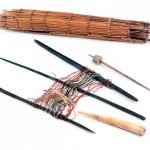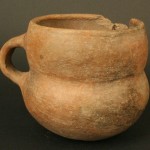Art
Arica ceramics display high technical quality and their painted polychromatic decorations feature anthropomorphic, zoomorphic and geometric designs. The level of standardization this ceramic tradition achieved reflects a solid identity, although the different styles are also in evidence—an earlier style, denominated San Miguel, with red- or black- on white designs, and the later Pocoma-Gentilar style, which features motifs in black, white and red on a natural colored background. Arica textiles also achieved a high level of technical and iconographic complexity. The most typical textiles of the Arica culture are the trapezoidal unkus, wide tunics that were fastened at the waist with a braided sash. Semicircular hats and bags (chuspas) were also typical products of the Arica people. The wooden or ceramic kero cups, which had originated in the previous period, now incorporated new motifs, such as the llama and the condor. A similar situation occurred with wooden spoons, which featured simpler decoration than in the prior period. Another key artistic development of the Arica culture were the geoglyphs, huge drawings constructed on hillside slopes. These displays were associated with the caravan routes that criss-crossed the region during that period.




